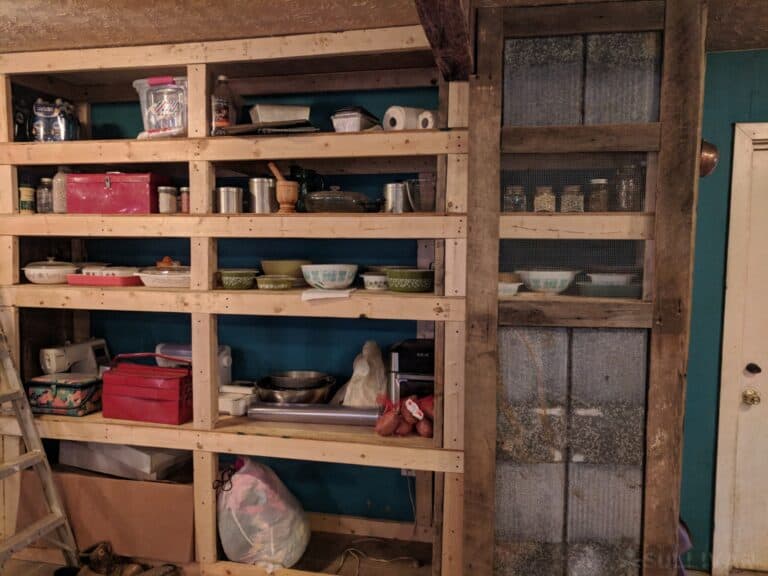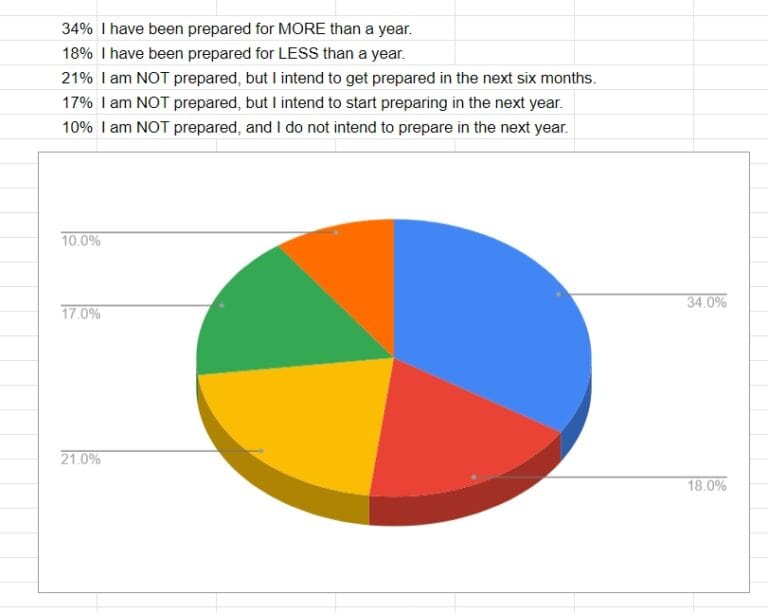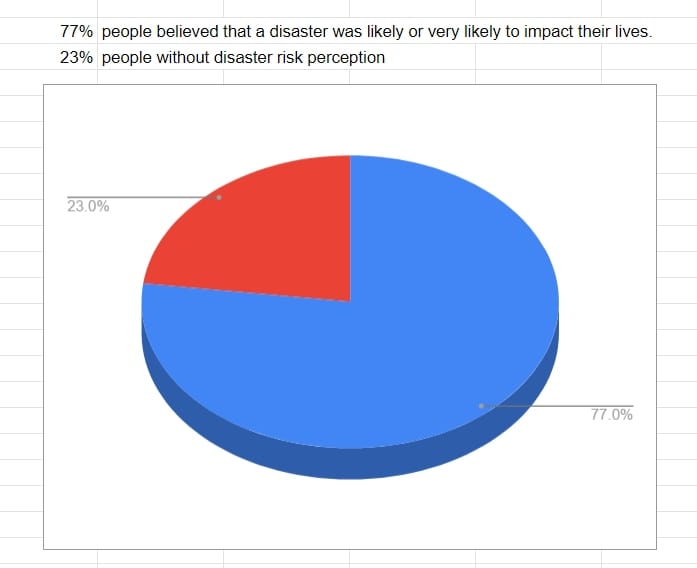I know at least some of you reading right now haven’t been prepping as long as some of us. I do not mean to insult, but I do mean to say that you haven’t lived through the state of disdain that some of us have.

DIY pantry shelves with various items stockpiled
For a time going into the early 2000s, preppers were treated as others- weirdos who were put in the spotlight and showcased on TV, movies, and video games as eccentric, paranoid, or even deranged.
But, of course, all of that changed with the pandemic. Even the government started taking the preparedness of citizens a lot more seriously, at least more seriously than it had done in many decades since the Cold War.
To that end, surveys and studies were both performed, and the insights into the state of prepping in America are quite illuminating.
By studying them, we can potentially glean some understanding of what the prepping landscape will look like going forward into 2024 and beyond. I’ve assembled the most important need-to-know statistics below and will be going over each of them line by line.

FEMA’s perceived preparedness survey results 51% of those surveyed say they’re ready for a disaster. That’s the majority!
FEMA NHS Results 2023
The following stats are taken from FEMA’s National Household Survey on Disaster Preparedness, commonly just referred to as the NHS. This survey was done with the explicit purpose of assessing preparedness actions among the citizenry as well as the attitudes and motivations towards it in the US.
Of course, being the government, they haven’t made it a point to assemble a sort of quilt out of all the disparate regions, communities, racial demographics, and more throughout the US in an effort to build a more complete picture.
We won’t be delving into that granular breakdown but will be focusing on the big-picture stats concerning preparedness activity and overall level of readiness among all citizens.
Correspondents
How many people took this survey? How is it conducted? This information is as important as the results themselves when it comes to properly evaluating what we are to learn from it. For the report, 7,604 people took a web-based survey to produce the following data. A tiny cross-section of the US population, to be sure, but a meaningful one!
Note that FEMA states they “adjusted” responses by demographic variables to better reflect the composition of the general public. With that in mind, let’s get to the numbers…
Professed State of Readiness
All the correspondents, 51% of adults professed that they were prepared for a disaster, or that they believed they were. 57% of all adults took three or more of the preparedness actions detailed in the following subsections.
What can we learn from this? Confidence counts for a lot, and about 50% of all people surveyed believed they were prepared for some kind of disaster.
The reality might be very different when put to the test, but this is promising. What’s more encouraging is that a little more than half of all adults took decisive action in order to get prepared. That speaks more than just confidence alone!
Assembled or Updated Supplies
This is a big one. 48% of all adults surveyed in 2023 reported that they assembled or updated their cache of supplies, compared to just 33% in 2022. We all know why that happened!
The mass stockpiling of all sorts of goods, namely masks, hand sanitizer, and toilet paper, and the pandemic makes this one something of a “gimme” but a win is a win.
Made a Plan
Interestingly, only 37% of correspondents reported that they made a plan in order to get ready for tough times, disasters, or contingency. This is down from 41% in 2022.
Why might this be? Maybe the numbers are down because people that have already made a plan don’t have to make a new plan, but it’s hard to say.
Made Their Homes Safer
36% of all people surveyed in the study claimed that they made their home safer in some way. This could be preparing for a fire, reinforcing against natural disasters, making a safe room or shelter, etc. Slightly up from 2022 where only 33% of respondents claimed to do so.
Signed Up for Alerts
Another interesting one. 36% of people surveyed reported that they signed up for some form of emergency alert or warning system, down from 46% in 2022.
Again, this might be attributable to the fact that, having signed up, no more sign-ups are needed among a certain sector of the populace. No information was provided regarding how many respondents unsubscribed from such warnings and alerts.
Saved Money
Saving for a rainy day is always good policy, but only 32% of people polled in the survey reported that they did just that. This is down from 36% who claimed that they saved money in 2022.
This one, to me, is obvious, thanks to the continuing economic woes most people are working harder and longer and struggling just to make ends meet. Saving money might actually be out of the question.
Learned Evac Routes
31% of folks asked in the 2023 survey reported that they learned evacuation routes for various natural disasters and other events. This is especially relevant for people living near the coasts or in wildfire-prone areas. Good news since that’s up from just 28% the preceding year.
Documented and Insured Property
It turns out that more folks are worried about losing the things they have worked so hard for. 30% of surveyed individuals claim that they documented and insured any type of property against loss or destruction, compared to just 25% in 2022.
Protected Important Docs
Making sure you can prove that you are who you say you are, and own what you say you own is critical in the aftermath of a disaster, and something that many preppers overlook.
That’s not showing much signs of improvement according to this survey, with just 30% of people reporting they have safeguarded their important docs, a tiny increase over last year’s percentage of 29%.
Tested Family Comms Plan
Another chronically neglected part of any good crisis response plan, a meager 18% of respondents showed that they implemented and tested a family communication plan. Barely an improvement over 2022’s 17%.
Practiced Emergency Drills or Habits
Statistic. Only 15% of people preparing for disaster in the United States, at least the ones that answer the survey, claim to have practiced any emergency drills or other habitual actions. Worse, that’s slightly down from last year’s 16%.
Got Involved in Community
Likewise, only 14% of all the people surveyed reported that they got involved with their neighbors in some way that was oriented towards mitigating the effects of disaster. I guess the good news is that’s up 4% from last year’s survey…
Planned with Neighbors
Another abysmal rating, 12% of correspondents did any sort of disaster planning with their neighbors, staying the same from last year.

The disaster risk perception chart. The vast majority believe a disaster will afect them.
Key Takeaways: Emphasis on Stuff, Logistics, and Early Warning
One way to read the above data is that there is a decided emphasis on stuff, the logistics of survival, the continuity of “personhood” via preservation of issued docs, and early warning concerning disasters and events.
This falls mostly in line with my own experience, where relatively few preppers, of any stripe, want to do the hard work of implementing fundamental plans and actions that can keep themselves and loved ones alive, things like:
- practicing drills and skills,
- implementing contingency plans with family,
- establishing backup communications,
- and building meaningful relationships with their community and even their very neighbors.
Half of Americans Believe in Prepping
Another fact that you might take away from the survey is that roughly half of all Americans believe they are prepared for a disaster and are actively taking action to become better prepared for disaster.
Now, we can argue about what is and is not prepared all day long, and at the risk of devolving into the “no true Scotsman” fallacy, people who are hyper-prepared might look disdainfully at folks who are just now assembling their very first 3-day kit.
The good news is that most Americans are self-reporting that, meaning that genuine prepping, or at least the notion of it is certainly on the rise.
The Other Half Does Not
But the other side of that coin, of course, is that half of America does not believe that they are prepared, or reports that they don’t believe prepping will do any good.
Whether you chalk that up to a lack of information, a lack of confidence, or just a spirit of nihilism that is seizing people in the aftermath of the pandemic, I cannot say.
It’s certainly distressing, and reason enough for the rest of us to get out here and put our best foot forward to help motivate people. Talk to your neighbors and your family, that’s an order!
The ‘Consumer Confidence’ Index
Another clue to the future and the outcomes we might all be facing is consumer confidence. Don’t worry, I’m not going off the rails into financial blog territory, but economic pressures are directly proportional to people’s view of society and “bad times”.
This is something else we should all keep in mind for our own sakes, because anarchy is just one bad market crash away.
Consider the following findings, taken from Finder’s own Consumer Confidence Index of 2023 which has polled more than 15,000 American adults:
- 79% of adults say they are stressed about their current finances, a figure that is rising over time.
- 31% of people say their household financial situation is worse than the year prior, another figure that is climbing steadily.
- 67% of correspondents say that the US is likely to enter a recession in the next year.
- Nearly 63% say that inflation has affected their spending, savings, and overall financial situation.
- 85% of correspondents are concerned about the rising costs of household expenses.
- 46% of correspondents fear being laid off within a year.
- And, most worryingly of all, only 25% of correspondents say they would be able to live off of savings for even a week if they lost their jobs.
Far and away, economic and financial loads are certainly in the top 5 concerns for most US citizens today.
Prepper Spending Activity
If you want to know what people really care about, watch where they spend their money. In another interesting survey from Finder, they determined that about a third of the adult population in the US has spent more than $11 billion dollars over the course of a year on preparedness actions and goods.
That sounds like quite a number! But considering the total adult population of the United States and how expensive prepping can be to establish total readiness, it actually seems low to me.
Let’s look at a breakdown below and see what we can glean from the data they collected.
Among participants, several items stood out as ones that people were consistently willing to spend a lot more money on. 6% of people surveyed invested an average of $1,057 into a savings account. That makes sense because savings are important for rainy days. That is still precious few people that are actually putting money in the bank, though.
A related metric is that 9% of survey responders claimed to sink an average of $468 into building an on-hand stash of cash. That is more logical to most of us, I’m sure! You can’t count on getting your money out of a bank in the middle of a major disaster or societal collapse. I think it’s a little curious that more people, but not that many more, would invest in having cash on hand but then have significantly less than their savings account.
Lastly, and someone curiously, 8% of survey responders spent an average of $580 on home renovations. Kind of a curious category, and Finder does not detail exactly what “home renovations” are in this context. It’s safe to say it might be things like improved locks and doors, shoring up other weak points and correcting structural deficiencies.
Another key takeaway is that many more people invested in the basics, things like food and water, toilet paper, and medical supplies with 21%, 15% and 14% of respondents respectively, though they spent far less on each of these than on the categories above.
Survival Specialist Professions
An interesting footnote, perhaps, and difficult to collate with the other data we have assembled today, there is a new and growing professional demographic described as survival specialists.
As tabulated by Zippia career experts, this diverse career field is populated mostly by men, with around 60% of all jobs held by them, and 40% by women, though women are increasingly involved in the sector.
What is a survival specialist? Zippia doesn’t say, but most of these positions entail a bachelor’s degree and are employed with the government, meaning they’re likely related to FEMA, the Department of Homeland Security, and other sectors responsible for individual and societal health and resiliency in the face of disaster and other trouble.
Certainly, the open classification and distribution of such jobs can only be seen as a positive when it comes to the acceptance and proliferation of prepping as a component of adulthood rather than some oddball lifestyle choice.
Make No Mistake: The Notion of Prepping is Now Truly Mainstream
Arguably good news, though I wish it had been popular and widely accepted sooner: prepping is truly mainstream when you have outlets like The Atlantic talking about it in a favorable light, admitting, however grudgingly, that those of us who had proper neighbors were likely neighbors with someone who was ready for the pandemic.
What does this mean for prepping going forward? It’s hard to say, but I would count on an influx of “joiners” who claim to have been doing it the whole time and eager for limelight and influence, not actual efficacy. Hold fast, folks!
The post Prepper Demographics and Stats for 2024 appeared first on Survival Sullivan.
By: Tom Marlowe
Title: Prepper Demographics and Stats for 2024
Sourced From: www.survivalsullivan.com/prepper-demographics-and-stats-2024-edition/
Published Date: Fri, 29 Mar 2024 15:30:27 +0000
------------------------
Did you miss our previous article...
https://bushcrafttips.com/bushcraft-news/mastering-urban-defense-essential-tactics-for-modern-warfare
 What is BushcraftSurvival SkillsToolsVideosBushcraft CampsBushcraft KitsBushcraft ProjectsPrivacy PolicyTerms And Conditions
What is BushcraftSurvival SkillsToolsVideosBushcraft CampsBushcraft KitsBushcraft ProjectsPrivacy PolicyTerms And Conditions
